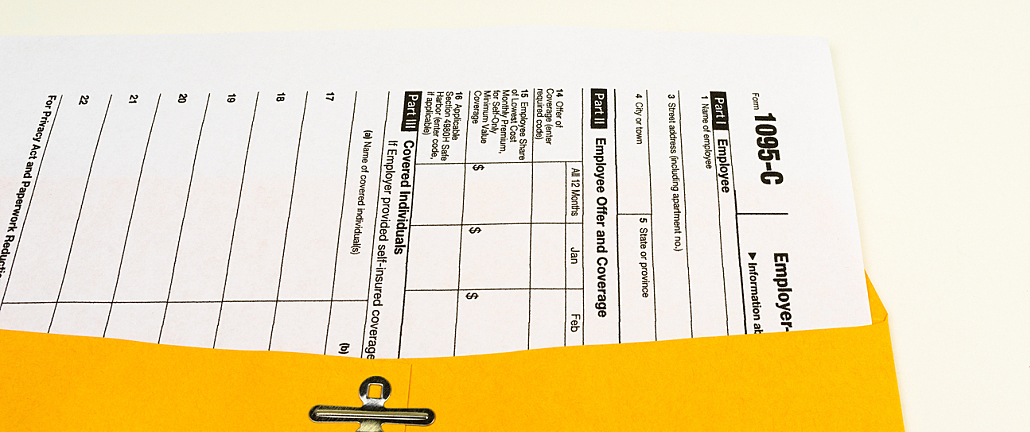Consolidating Data for ACA Forms: Start Early and Plan Ahead

When it's time to file your taxes, there's no doubt that it's better to be the person with organized records that have been cross-checked throughout the year, as opposed to being the person who has a shoe box full of receipts and not much else. The same holds true for organizations consolidating data for Affordable Care Act (ACA) forms. Striving to keep your yearly record-keeping as efficient as possible will help you more effectively comply with Internal Revenue Code sections 6055 and 6056 of the ACA and forms 1094-C and 1095-C and will help you stay on schedule and reduce the risk of errors overall.
In early 2016, when employers were consolidating data for ACA forms, 40 percent reported that Forms 1094-C and 1095-C took longer than the IRS said they should, according to ADP research reported in Four ACA Compliance Challenges Still Impacting Employers. The biggest obstacle, according the ADP analysis? The benefits and HR data necessary for completing the forms wasn't ready or easily accessible.
Unless you're using a third-party service to handle your ACA reporting, the practical realities of consolidating data for ACA forms can be headache-inducing. But there are steps you can take now to make next year's reporting — and future years — easier and faster.
Reach out to Your Insurance Carrier
If you offer fully insured plans, ask your carrier to give you a master file showing all covered employees and the months for which they're covered. If they can't get this to you, or can't do so in a timely fashion, you can implement a process for reconciling the details in the carrier's monthly bill (showing names of covered employees) with your HR records.
You can also use tailor-made ACA record-keeping software to help you with this process, making it much simpler to reconcile on a monthly basis so you don't have to sort it all out at the end of the year. It's also easier to catch errors if you're monitoring this process continuously.
If you self-insure, you'll want to implement a system for keeping track of which employees have coverage each month, and whether the coverage meets the ACA's affordability and minimum value requirements.
Understand the Codes and Filing Requirements Ahead of Time
Brush up on the codes that are used on Line 14 and Line 16 of Form 1095-C. This is where you indicate which safe harbor method you're using to ensure that coverage is affordable, whether the coverage you're offering is minimum essential coverage that provides minimum value, whether your employee accepted the coverage and whether the employee was considered full-time during each month of the year.
You'll want to implement a system for keeping track of employees that decline your coverage offer, including the date that the coverage was offered and declined. Keep in mind that you have to offer coverage annually to your ACA full-time employees, so you'll want to update the offer date each year, and if applicable, the decline date. There are software programs and service providers that can help you keep track of your employees' coverage offers, along with whether the offer was accepted or declined.
You should also have a system for determining the amount each employee pays per month including the amount the employee would pay for the lowest cost self-only coverage available (whether or not self-only coverage is elected), and compare it with wage data to ensure that the coverage you're offering is affordable, assuming you're using one of the safe harbor methods that incorporate the employee's actual pay, rather than the federal poverty level.
Carefully Track and Educate Your Employees
Depending on which tracking method you're using to determine whether an employee is full-time, you can work with your payroll vendor to maintain data regarding your employees' hours throughout the year. Or you may be eligible to use the "98 percent offers" method, as noted by the U.S. Government Publishing Office, which will cut back on some of the data tracking and consolidation you need to do.
Educate your employees about the purpose of Form 1095-C, and ask them to alert you to any errors that they see. Your ACA reporting to the IRS is due later in the year than the reporting to your employees, so this may provide an opportunity to fix errors reported by your employees before you file.
Get Prepared- An Extention Isn't Guaranteed
If you think there's a chance you might struggle to get your ACA reporting completed on time, you can use Form 8809 to request an extension to the deadline for filing Forms 1094-C and 1095-C, according to the IRS. There was an automatic extension in 2016 for 2015 reporting, but that's unlikely to be repeated in future years. Recent ADP research also indicated that a significant number of employers would not have met the original deadline in 2016. Filing for an extension will give you an extra 30 days to file with the IRS, however, while an extension is not guaranteed to be granted...so your best bet is to prepare now.
By giving yourself added flexibility combined with updated tracking systems, you can make compliance easier and reduce the number of deadline-related errors you may have experienced in the past.



